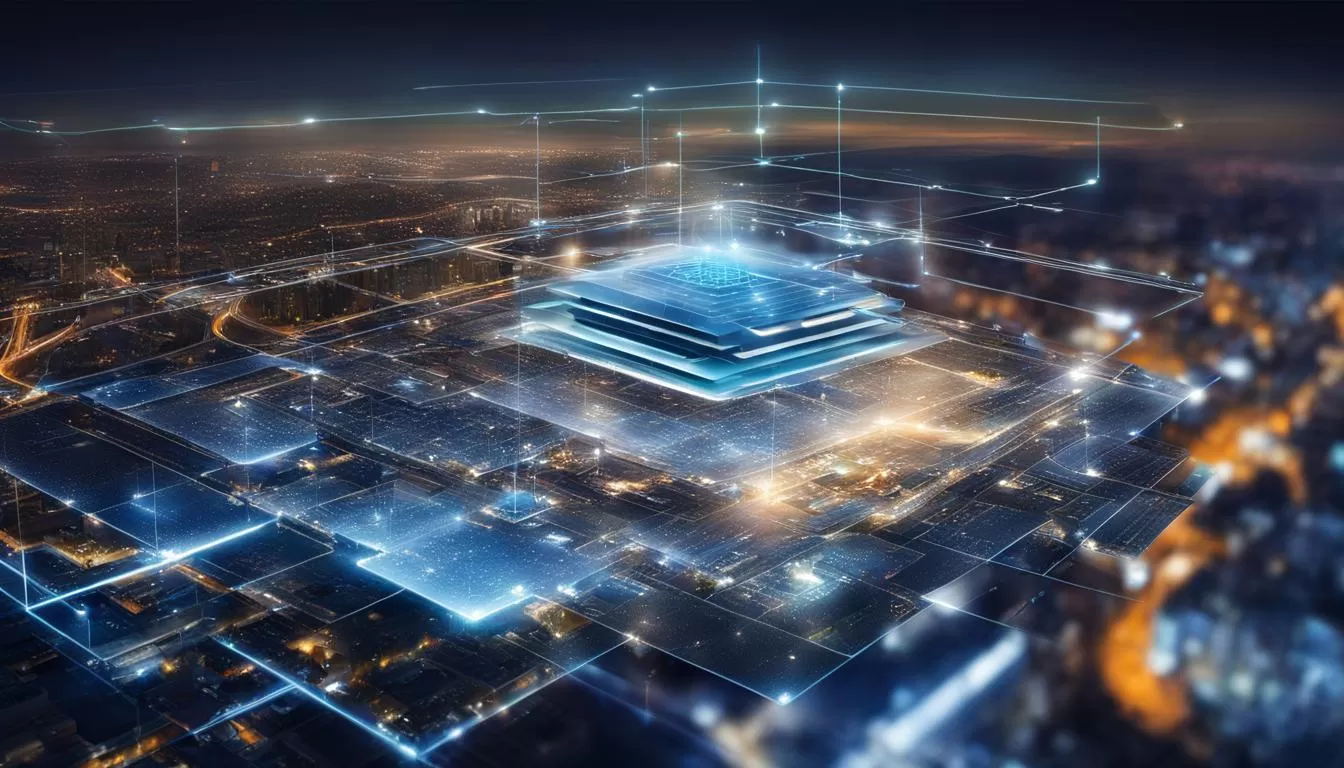Written By:
Scott McAuley
Scott is the IT Director of Texas Management Group, and has been in the IT industry for 25 years.
Welcome to the world of edge computing and its impact on IoT and 5G. In this article, we will explore how edge computing revolutionizes data processing and computing power at the network edge, empowering digital transformation in various industries.
By bringing computing and data closer together to the network edge, edge computing enhances connectivity, efficiency, and the ability to harness real-time data insights.

Key Takeaways:
- Edge computing brings processing power and data storage closer to the network edge, enabling faster data processing and reducing latency.
- Edge computing plays a crucial role in IoT and 5G by enabling local processing, faster data analysis, and improved network speeds.
- 5G networks benefit from edge computing through enhanced mobile broadband, reduced latency, and support for mission-critical services.
- Edge computing enables digital transformation, improves operational efficiency, and creates new business opportunities in various industries.
- The combined power of edge computing and 5G unleashes the potential for accelerated advancements in IoT, connectivity, and the overall digital landscape.
Table of Contents
What is Edge Computing?
Edge computing is a revolutionary concept that brings computing power and data storage closer to the network edge. Unlike traditional cloud-based computing, where data is processed in centralized data centers, edge computing enables real-time data processing and analysis at the edge of the network. This decentralization of processing power reduces latency and enables faster data processing, leading to improved efficiency, responsiveness, and user experience.
By moving computing power closer to edge devices and networks, edge computing unlocks a range of benefits. It allows for faster data processing by eliminating the need to transmit large amounts of data to centralized data centers. This localized processing capability not only reduces latency but also enhances the ability to perform real-time analytics and deliver personalized experiences.
Edge computing is particularly advantageous in scenarios where low latency and high-speed data processing are critical. It empowers edge devices such as sensors and IoT devices to analyze data locally, making it ideal for applications that require instant responses or involve large-scale data generation.
With edge computing, businesses and industries can harness the power of computing at the edge to unlock new possibilities, improve operational efficiency, and drive innovation.
Advantages of Edge Computing:
- Reduces latency and enables faster data processing
- Allows for real-time analytics and personalized experiences
- Enables local processing of data generated by edge devices
- Improves efficiency, responsiveness, and user experience
Edge Computing Use Cases:
Edge computing has diverse applications across industries. Some notable use cases include:
| Industry | Use Case |
|---|---|
| Manufacturing | Real-time monitoring and optimization of production processes |
| Transportation | Efficient management of fleets and real-time traffic analysis |
| Healthcare | Remote patient monitoring and real-time alert systems |
| Retail | Personalized shopping experiences and inventory management |
| Smart Cities | Smart traffic management and intelligent infrastructure monitoring |

These are just a few examples of how edge computing is transforming industries and enabling innovative solutions. As the adoption of edge computing continues to grow, we can expect to see even more groundbreaking applications and advancements in computing power, data processing capabilities, and network edge technology.
The Role of Edge Computing in IoT and 5G
Edge computing and its impact on IoT and 5G plays a crucial role in enabling the seamless integration of newly found technologies. By leveraging the power of edge computing, organizations can unlock the full potential of IoT data and improve network speeds, local processing, and low-latency communication.
This section will explore the various applications of edge computing in IoT and 5G, highlighting the benefits it brings to data generation, sensor data analysis, and network optimization.
Edge Computing Applications
Edge computing offers a wide range of applications in the context of IoT and 5G. One of its key advantages is the ability to process data locally, closer to the source. This significantly reduces the need for transmitting large amounts of data to centralized data centers, resulting in lower latency and improved network speeds.
With edge computing, IoT devices can perform real-time analytics, enabling organizations to make data-driven decisions faster. Additionally, edge servers equipped with edge computing capabilities enhance the efficiency and effectiveness of data processing in IoT and 5G networks.
Improved Data Generation and Analysis
Edge computing also enhances data generation and analysis in IoT environments. By processing data at the edge, organizations can generate valuable insights from sensor data in real-time. This enables proactive decision-making and the implementation of predictive maintenance strategies, increasing operational efficiency.
Furthermore, edge computing enables data analysis at the source, reducing the need to transmit large volumes of data to the centralized cloud. This not only accelerates data processing but also minimizes bandwidth requirements, making it ideal for resource-constrained IoT devices.
Optimized Network Speeds and Low Latency
One of the key advantages of edge computing in IoT and 5G is its ability to optimize network speeds and reduce latency. By leveraging local processing capabilities, edge computing enables faster data transfer and analysis, resulting in improved overall network performance.
This is particularly crucial for latency-sensitive applications such as autonomous vehicles, remote healthcare monitoring, and industrial automation. Edge computing ensures that critical data is processed and acted upon in real-time, enabling quick response times and superior user experiences.
| Edge Computing Applications | Benefits |
|---|---|
| Real-time analytics | Enables faster data-driven decision making |
| Local data processing | Reduces latency and improves network speeds |
| Improved data generation | Enables real-time insights from sensor data |
| Low-latency communication | Supports latency-sensitive applications |
5G and Edge Computing
Edge computing brings significant benefits to 5G networks, revolutionizing the way we experience mobile broadband and empowering the future of connectivity. By leveraging edge computing capabilities, 5G networks can deliver enhanced mobile broadband with faster data transmission and reduced latency, ensuring seamless and responsive user experiences.
One of the key advantages of edge computing in 5G is that it requires ultra-reliable, low-latency communication. With edge computing, data processing and analysis occur closer to the network edge, minimizing the time it takes for information to travel between connected devices and servers.
This ultra-reliable, low-latency communication enables real-time interactions, which is critical for applications such as autonomous vehicles, remote surgery, and smart city infrastructure.
Moreover, edge computing enhances network reliability in 5G. By distributing computing power and data processing across edge servers, the network becomes more resilient and less susceptible to disruptions. This is crucial for mission-critical services that require uninterrupted connectivity and high levels of reliability, such as emergency response systems and industrial automation.
Another significant benefit of edge computing in 5G is its ability to deliver network speeds to handle high bandwidth applications. With edge computing capabilities, 5G networks can support bandwidth-intensive applications like augmented reality, virtual reality, and high-definition video streaming. This enables immersive experiences and seamless real-time processing, transforming how we interact with digital content and opening up new opportunities in entertainment, gaming, and communication.
| Benefits | Description |
|---|---|
| Enhanced Mobile Broadband | Faster data transmission, enabling seamless streaming and downloads |
| Low Latency Communication | Real-time interactions for critical applications like autonomous vehicles |
| Network Reliability | Distributed computing power for a more resilient and reliable network |
| High Bandwidth Support | Ability to handle bandwidth-intensive applications like augmented reality |
| Mission-Critical Services | Uninterrupted connectivity and reliability for emergency response and industrial automation |
The Impact of Edge Computing on Industries
Edge computing and its impact on IoT and 5G has revolutionized industries across the board, driving digital transformation and unlocking a world of new possibilities. By decentralizing data processing and reducing reliance on centralized data centers, edge computing offers numerous benefits, including improved operational efficiency, reduced energy consumption, and the creation of a robust ecosystem.
One of the key advantages of edge computing is its ability to empower businesses in both major cities and remote locations. By using edge networks and bringing computing power closer to the network edge, organizations in major cities can experience enhanced connectivity and faster data processing, enabling them to make real-time decisions and deliver seamless experiences to their customers.
In remote locations, such as rural areas or regions with limited network infrastructure, edge computing plays a vital role in providing essential services. For example, emergency services can leverage the computing capabilities of edge computing to process critical data locally, enabling faster response times and potentially life-saving interventions. This is particularly crucial in scenarios where network connectivity may be intermittent or unreliable.
Table: Industries Benefiting from Edge Computing
| Industry | Impact of Edge Computing |
|---|---|
| Healthcare | Real-time data analysis, remote patient monitoring, improved medical resource allocation. |
| Transportation | Real-time traffic management, predictive maintenance, optimized logistics. |
| Manufacturing | Smart factories, predictive maintenance, quality control, real-time monitoring. |
| Retail | Personalized customer experiences, real-time inventory management, optimized supply chain. |
| Energy | Smart grids, efficient energy management, predictive maintenance. |
Moreover, edge computing enables businesses to capitalize on new business opportunities and drive innovation. Industries such as healthcare, transportation, manufacturing, retail, and energy can leverage edge computing to achieve operational efficiency, automate processes, and deliver enhanced services. This opens up avenues for revenue growth, improved customer experiences, and a competitive edge in the market.
In conclusion, edge computing is transforming industries by accelerating digital transformation, reducing energy consumption, and creating new business opportunities. Whether in major cities or remote locations, the impact of edge computing is far-reaching, and wireless technology empowers organizations to leverage real-time data insights for improved operations and customer experiences.

Conclusion
Edge computing and its impact on IoT and 5G will allow for more technological innovation and empowering digital transformation. By bringing computing power and data processing closer to the network edge, edge computing enhances connectivity, efficiency, and the ability to harness real-time data insights. The combination of edge, cloud computing, and 5G opens up new possibilities for industries, improves operational efficiency, and creates new business opportunities.
As we continue to embrace the potential of edge computing, we can expect to see accelerated advancements in artificial intelligence, IoT, 5G, and the overall digital landscape. The impact of edge computing on data processing, computing power, and the network edge will continue to drive transformation and create new opportunities for industries in the United States and beyond.
Exploring Ways to Future-Proof Your Network?
Access our blogs for the latest on edge computing’s role in IoT and 5G, and see how our Network Management and Monitoring Services support continuous, robust network performance.
Strengthen your connectivity!
FAQ
What is Edge Computing?
Edge computing and mobile edge computing bring processing power and data storage closer to the network edge, enabling faster data processing and reducing latency. Unlike traditional cloud-based computing, edge computing allows for real-time data processing and analysis.
What Role Does Edge Computing Play in IoT and 5G?
Edge computing and its impact on IoT and 5G allows for local processing and reducing the transmission of large amounts of data to centralized data centers. This allows for advanced analytics, faster data analysis, reduced latency, and improved network speeds.
How Does Edge Computing Benefit 5G Networks?
Edge computing enhances 5G networks by using network traffic and providing enhanced mobile broadband with faster data transmission, reduced latency, and high bandwidth. It ensures network reliability and supports mission-critical services, as well as bandwidth-intensive applications like augmented reality.
What Impact Does Edge Computing Have on Industries?
Edge computing enables digital transformation, improves operational efficiency, and creates new business opportunities. It reduces reliance on centralized data centers, leading to lower energy consumption and improved data center resource utilization. Various industries benefit from the low latency and real-time processing capabilities of edge computing, including healthcare, transportation, and emergency services.






